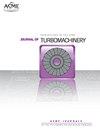过渡和湍流在多尺度表面粗糙度上的直接数值模拟。第二部分:粗糙度对高压涡轮叶片性能的影响
IF 3.1
3区 工程技术
Q3 ENGINEERING, MECHANICAL
引用次数: 0
摘要
涡轮叶片通常存在制造过程中引入或使用过程中退化引起的表面粗糙度,这对气动热性能有重大影响。更好地了解在发动机相关条件下粗糙度和涡轮流动之间相互作用所产生的基本物理机制,可以为提高效率和延长使用寿命的叶片设计提供见解。为此,采用高保真数值框架,结合经过验证的直接数值模拟求解器和二阶精确浸入边界法,对发动机相关工况下LS89高压涡轮(HPT)叶片的粗糙度气动热效应进行了预测。研究了不同表面粗糙度的幅值和分布,并进行了相同流动条件下的参考光滑叶片模拟进行比较。增大幅度的粗糙度使叶片吸力侧边界层过渡向上游移动,产生更大的湍流动能和更高的总尾迹损失。数值框架的表面数据捕获能力提供了热流密度和表面摩擦系数的直接测量,从而提供了表面拓扑和工程相关性能参数之间的定量信息。这一工作为未来涡轮机械流动粗糙度的数值研究提供了一个基准。本文章由计算机程序翻译,如有差异,请以英文原文为准。
Direct Numerical Simulation of transitional and turbulent flows over multi-scale surface roughness - Part II: the effect of roughness on the performance of a high-pressure turbine blade
Abstract Turbine blades generally present surface roughness introduced in the manufacturing process or caused by in-service degradation, which can have a significant impact on aero-thermal performance. A better understanding of the fundamental physical mechanisms arising from the interaction between the roughness and the turbine flow at engine-relevant conditions can provide insights for the design of blades with improved efficiency and longer operational life. To this end, a high-fidelity numerical framework combining a well-validated solver for Direct Numerical Simulation and a second-order accurate immersed boundary method is employed to predict roughness-induced aero-thermal effects on an LS89 high-pressure turbine (HPT) blade at engine-relevant conditions. Different amplitudes and distributions of surface roughness are investigated and a reference smooth-blade simulation under the same flow conditions is conducted for comparison. Roughness of increasing amplitude progressively shifts the blade suction side boundary layer transition upstream, producing larger values of the turbulent kinetic energy and higher total wake losses. The on-surface data-capturing capabilities of the numerical framework provide direct measurements of the heat flux and the skin friction coefficient, hence offering quantitative information between the surface topology and engineering-relevant performance parameters. This work may provide a benchmark for future numerical studies of turbomachinery flows with roughness.
求助全文
通过发布文献求助,成功后即可免费获取论文全文。
去求助
来源期刊
CiteScore
4.70
自引率
11.80%
发文量
168
审稿时长
9 months
期刊介绍:
The Journal of Turbomachinery publishes archival-quality, peer-reviewed technical papers that advance the state-of-the-art of turbomachinery technology related to gas turbine engines. The broad scope of the subject matter includes the fluid dynamics, heat transfer, and aeromechanics technology associated with the design, analysis, modeling, testing, and performance of turbomachinery. Emphasis is placed on gas-path technologies associated with axial compressors, centrifugal compressors, and turbines.
Topics: Aerodynamic design, analysis, and test of compressor and turbine blading; Compressor stall, surge, and operability issues; Heat transfer phenomena and film cooling design, analysis, and testing in turbines; Aeromechanical instabilities; Computational fluid dynamics (CFD) applied to turbomachinery, boundary layer development, measurement techniques, and cavity and leaking flows.

 求助内容:
求助内容: 应助结果提醒方式:
应助结果提醒方式:


